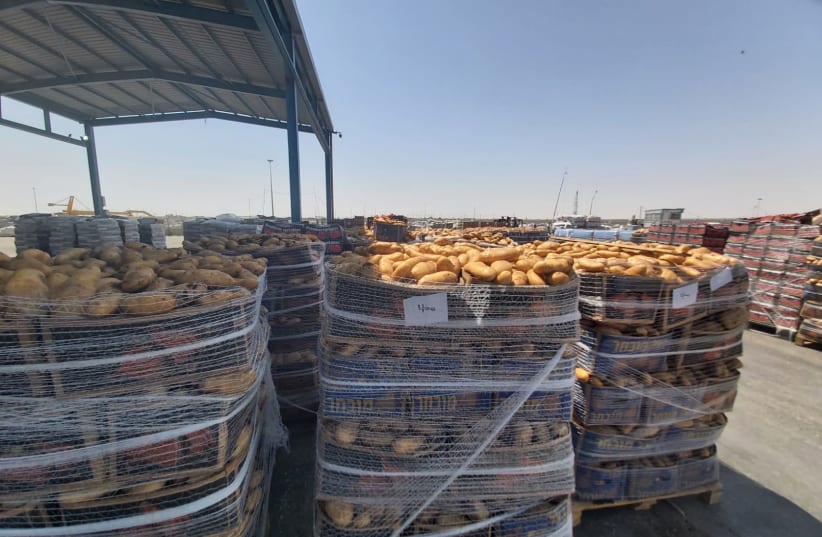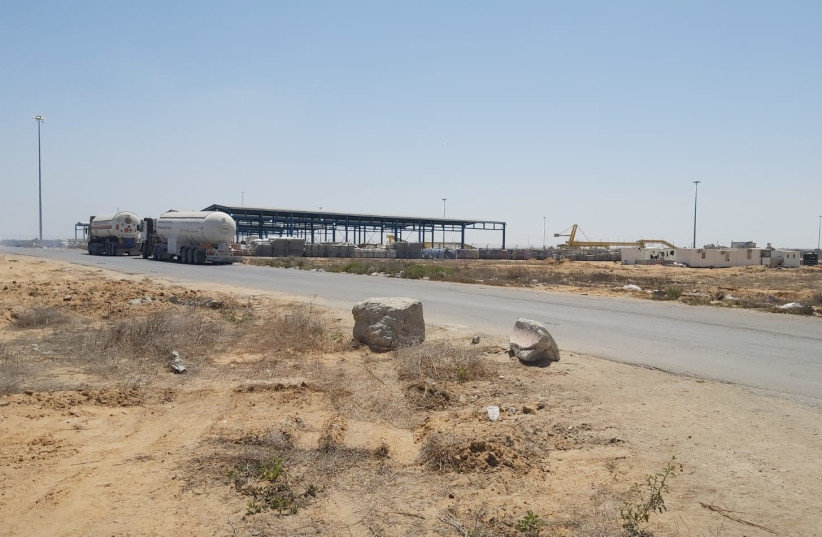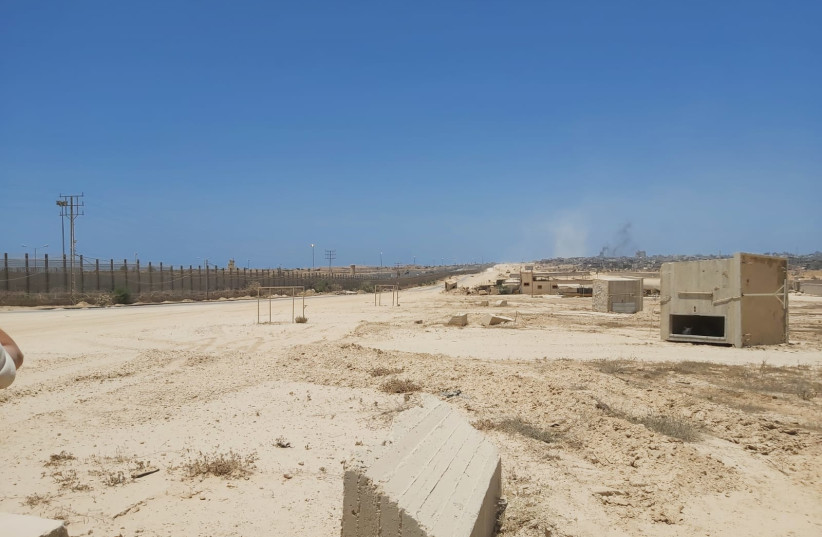RAFAH – Throughout the current war, a running theme has been condemnation of Israel for impeding the flow of humanitarian aid to Gazan civilians.
The Jerusalem Post’s journey last week embedded with IDF units from the Kerem Shalom crossing to the Rafah crossing was an up-close look at the humanitarian aid story, but also highlighted some critical issues that most of the world has ignored, as well as some dilemmas that Israel ignores at its peril.
These crossings have been the key points through which humanitarian aid to Gazans has entered during most of the war, but there have been significant ups and downs in their use.
When critics of Israel claim that the IDF prevented aid coming through from Kerem Shalom, they are partially right and partially wrong.
Blocking and enabling aid to Gaza
In the days immediately after October 7, the IDF was focused on killing, arresting, or ousting Hamas invaders from Israeli territory, but from October 12-21, that was no longer a paramount concern.
Yet, for a few days early in the war, Israel was blocking the transfer of water and said it would continue to block it.
In the end, Israel facilitated the transfer of water, and eventually opened up the Nitzana crossing for a wider variety of humanitarian aid.
But those initial two weeks set a negative tone globally and provided fodder for critics long after Jerusalem was on-board with humanitarian aid.
In any event, from October 21 until the end of the month, some 241 trucks went through the Nitzana crossing. Egypt also opened the Rafah crossing on October 21, which it had closed on October 7, initially allowing 20 trucks of aid per day to cross into Gaza, increasing to around 200 trucks per day.
In November, some 2,615 trucks crossed at Nitzana, a big increase compared to the end of October.
In December, there were 2,479 trucks entering from Nitzana, keeping to a similar rate of around 80 trucks per day, but in mid-December, the Kerem Shalom crossing opened.
By January, Kerem Shalom had topped Nitzana with 2,614 trucks compared to 2,423 for a total of more than 160 trucks per day coming in from Israel. For most of the time since then, Kerem Shalom has been the most critical crossing point on the Israeli side for the transfer of humanitarian aid to Palestinians.
The timing of the big shift to Kerem Shalom and the much expanded truck transports was not coincidental.
Around the same time, the IDF attained operational control over northern Gaza and had Hamas on the run in Khan Yunis, smothering rocket fire. This created much safer conditions for distributing aid and for doing so during more hours of the day. It also led the US to pressure Israel more to open up for humanitarian aid faster.
All of this was in addition to continuing aid from Egypt through the Rafah crossing.
In February, some 1,039 trucks entered from Nitzana and 1,941 from Kerem Shalom, a drop of 40%, which the IDF blamed on a mix of UN withdrawals due to concerns of violence as well as Israeli protesters hampering transfers over a two-week period.
Eventually, the IDF stepped in to keep Israeli protesters away and Jerusalem also cut deals with the World Food Program (WFP) to take over large portions of UNRWA’s aid distribution program.
The IDF and the Defense Ministry said in March and April that the plan was to massively increase aid, and to sideline UNRWA so that Hamas would be cut out of the “food chain.”
In other words, having defeated Hamas militarily in northern Gaza and the Khan Yunis portion of southern Gaza, Israel was ready to start working on replacing Hamas as a political authority managing Gazans’ lives.
Israel reasoned that as long as Hamas controlled food distribution, it would physically and emotionally control Gazans and their future.
An additional element in all of this was replacing UNRWA – the UN organization most deeply infiltrated by terrorists – with the WFP, the World Central Kitchen (WCK), and other organizations with “clean hands.”
It is important to note that by April, Rafah was letting in 300 trucks a day, and that Israel was allowing a spike of around 500 trucks per day at one point, through Kerem Shalom, Nitzana, and the newly reopened Erez crossing, as well as from Jordan and by opening the Ashdod port to aid.
Then came May.
When Israel – after a four-month period of altering its plans repeatedly to reduce US and Egyptian opposition – finally invaded Rafah, Cairo slammed the doors shut on the Rafah crossing.
Also, Negev Brigade Commander Col. Elbaz Ivri told the Post last week that as the IDF invaded, a huge crowd of Palestinians dove into the area and took off with all of the remaining humanitarian aid – leaving the area barren.
By this week when the Post visited the Rafah crossing, which had provided up to 300 trucks of aid per day to Gazans for much of the war, it was not only shuttered, but completely run down – it looked like it had been abandoned for years.
Debris and destruction lay everywhere, though the large outer and inner gates for the crossing were still standing.
The Egyptian flag fluttered in the hot breeze only 50 meters away and Egyptian guards were looking down on our visiting crew from their towers. But other than that, the area which had been a lifeline for the Palestinians was deserted.
There is no question that there were days when fighting between Israel and Hamas disrupted the Rafah crossing. But there is zero fighting going on there now: not there, and not in distant neighborhoods.
Hamas may have booby-trapped Rafah more than any other area of Gaza, but its fighters also fled faster and more comprehensively than from any other area.
The Post did encounter some munition strikes and gunfire from a distance, but there has been no reason why Egypt could not have opened the Rafah crossing a month ago.
The Rafah closure is all about Egyptian politics.
Surprisingly, some senior IDF officials have expressed understanding of Cairo’s predicament.
Egypt has said it will only reopen the Rafah crossing when Palestinians are operating on the Gaza side, so they will not be accused of cooperating with an Israeli occupation of Gaza.
This might happen at some point, and much of the Israeli defense establishment might even support such an initiative.
But as long as Prime Minister Benjamin Netanyahu is opposing Palestinian Authority involvement of any kind in Gaza, Egypt will likely hold fast and keep the crossing shut.
For several weeks, Israeli and Western officials were worried that this could lead to a new humanitarian crisis.
But in late May, Egypt agreed to divert the humanitarian aid being flown into its territory from around the world to the Kerem Shalom crossing.
The Post also witnessed enormous amounts of aid upfront at Kerem Shalom.
There were vast stacks of potatoes, a variety of fruits, water, and a number of other humanitarian staples from a spectrum of countries.
The area was staffed by local Palestinians who have been handling the aid since long before the war and who are approved by the Shin Bet (Israel Security Agency).
They were friendly enough to the Post, though they spoke very little Hebrew.
Elbaz said that he and his soldiers get along very well with the humanitarian aid crew.
But the bottom line of the Post’s visit to Kerem Shalom was that it is a vast, well-oiled machine. Specific trucks come to pick up select products, while others pick up other categories of products.
When the Post was there, only a few dozen trucks were nearby to pick up aid, but IDF sources said that trucks are moving around that area at different times.
Accusations of a planned Israeli starvation policy are not merely untrue – they are blatantly disprovable to anyone who visits Kerem Shalom and sees the vast amount of supplies.
One can debate what should have happened between October 12 and 21, but there is no evidence that any sizable group of people starved during that time period – nor is there any evidence that any sizable group of Palestinians starved to death at any point in the war, even if the food situation has been very problematic at times.
Coming back to the trucks, there are restrictions on the hours when they can transport the aid into Gaza safely, but that’s another story.
And that is also the most disturbing story from Israel’s perspective.
Despite working hard to facilitate humanitarian aid on both sides of the Gaza border – and despite its efforts to replace UNRWA with the WFP and WCK – IDF sources told the Post that Hamas is still intercepting 100% of the aid.
This means that Hamas is still feeding all of Gaza, which means that the process of dethroning them politically has still not even begun nine months into the war, and three months after WFP and WCK were brought in to solve the UNRWA problem.
If Hamas still controls food distribution in Gaza, UNRWA, whether disbanded or not, becomes almost an irrelevant footnote.
IDF sources, off the record, will admit that this issue is the elephant in the room, or in this case the dilemma which still holds the key to the fate of the whole Gaza Strip.
This also leads into an even deeper danger.
Right now, the world is providing humanitarian aid to Gaza based on the premise that Israel will at some point withdraw and some hybrid of Palestinians and third parties like the UAE, Egypt, the US, and EU will step in.
But what if that takes too long?
At some point, the world and the aid groups could turn back to Israel and say, hand over Gaza or it is yours, including not just the job of facilitating aid, but also paying for it.
This is a scenario Israel needs to avoid.
In the meantime, critics and global media should visit the Rafah and Kerem Shalom crossings to see the real aid story up close.
Some critics may be accusing Israel of starving Palestinians because of antisemitism, some because of foolish and callous statements the Jewish state made in the first couple weeks of the war, and some because once they absorb the Hamas-run Health Ministry figure of 37,000 civilians killed (even though probably close to 40-50% were combatants), it makes it easier to believe that Israel would stoop to starvation as well.
But some of it is because Netanyahu does not talk it up, afraid that he will be attacked by his far-right flank for being too merciful.
The IDF is bringing reporters now to all of the relevant areas. Critics and global media should also do the footwork and check out the real story.


